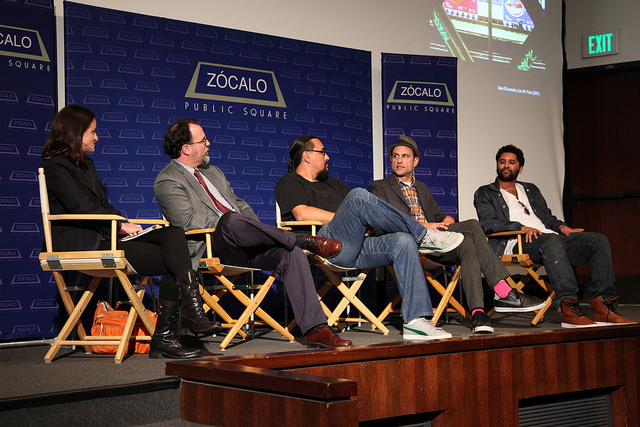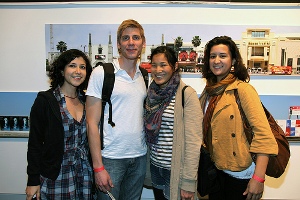
It’s unclear at exactly what point street art became a cultural phenomenon, but for Retna it was long apparent: “We always knew it… just took the public a while.”
If the eager, packed house at the Fowler Museum was any indication, Retna, a street artist, was prescient about the power of this renegade form of expression. He joined artist and gallery owner Man One, Fowler curator Patrick Polk, co-curator of MOCA’s street art exhibition Aaron Rose, and Los Angeles Times arts writer Jori Finkel to discuss the street art community, the role of the artist, and the form’s illegal underpinnings and commercial future.
What’s the draw?
 Rose explained the blossoming of graffiti art. “I think it has to do a lot with a generational shift. We grew up with it as our daily cereal in the morning. The ’60s had flower power and the next generation had punk and graffiti and that sort of permeated the culture,” he said.
Rose explained the blossoming of graffiti art. “I think it has to do a lot with a generational shift. We grew up with it as our daily cereal in the morning. The ’60s had flower power and the next generation had punk and graffiti and that sort of permeated the culture,” he said.
Rose came to street art from a place of playfulness; the subversive elements and fun were part of his attraction. “To me it is a game,” he said. But for Man One and Retna, it was their outlet from gang life and violence. “It’s what saved me,” Man One confessed, recalling having guns and knives pulled on him when he was younger. “There’s an innate need for us to voice who we are…and to me, that’s serious.”
As a curator, Polk’s draw to street art came from the visceral, transcendent moments it can spark for anyone wandering through a city. A week or so earlier, Polk recalled that he and his wife had driven down a street they frequented. Something had caught his eye: a spray-painted face on a white fence. His wife hurried him along to their engagement, but he returned to the spot later. He examined the art closer and saw not only the face, but candles, shattered glass, and a dented tree nearby. It was clear to Polk that a person had died there. “For me, it’s a space that has had no meaning suddenly becoming a place of mourning of grieving,” he said. “And now for the rest of my life, that will never be just a white fence.”
Retna agreed that street art isn’t only about artists, but also about the people who pass each piece every day. He said his work – from “ego-based” pieces with “the crew” to murals for the homeless on Skid Row – is always been about the people. “I always felt the work was community-related regardless,” he said. “Something that makes you smile for 20 seconds out of your day.”
Community and the code of ethics
 Man One was quick to set up the distinction between street art, which he believed to be an “all-encompassing kind of thing”, and graffiti, which he described as an art that took a lot of years of “practice and dedication.” Graffiti has a set of rules and even a culture, almost a code of ethics, he explained.
Man One was quick to set up the distinction between street art, which he believed to be an “all-encompassing kind of thing”, and graffiti, which he described as an art that took a lot of years of “practice and dedication.” Graffiti has a set of rules and even a culture, almost a code of ethics, he explained.
Moderator Finkel noted this sense of community, salient among street artists, defies our sense of the lonely, starving artist. Rose, however, saw this unity as a recurring historical pattern for artistic counterculture. “Avante-garde artists are ostracized from the main art world,” he explained, “and every major movement was collaborative.”
Man One described the broad street art community as his go-to: “I can travel half way around the world and have a place to stay and a place to paint and have a tour guide that may not even speak my language, but we have a commonality.”
During Q&A, an audience member asked whether women have a place in the street art world. Retna explained that women have always been there but, “It’s a difficult sport to play. There’s a lot of pain, there’s a lot of struggle. You got to get dirty.” He did note that more and more women were joining the ranks and receiving recognition.
Gangs, cops, and Warhol
 It’s hard not to fear that some parts of the community have a darker side, as the panelists admitted and confronted. Though gang life does to some extent define street art in Los Angeles, as Finkel pointed out, it’s also “one thing that freaks people out.” In the early ’90s, Man One explained, gangs and graffiti were thrown together. In Germany, he said, an elderly woman might shrug off his illegal acts, but in L.A., “You’ll be up there doing a commissioned piece and you’ll have police officers out there with guns on you, people honking at you,” he said. “It’s what makes L.A. L.A.”
It’s hard not to fear that some parts of the community have a darker side, as the panelists admitted and confronted. Though gang life does to some extent define street art in Los Angeles, as Finkel pointed out, it’s also “one thing that freaks people out.” In the early ’90s, Man One explained, gangs and graffiti were thrown together. In Germany, he said, an elderly woman might shrug off his illegal acts, but in L.A., “You’ll be up there doing a commissioned piece and you’ll have police officers out there with guns on you, people honking at you,” he said. “It’s what makes L.A. L.A.”
Retna, recognizing that gangs controlled his neighborhood growing up, embraced some aspects of gang culture as having influenced his writing, particularly the “territorial look” that he incorporates into his work. “Those were the people that I used to look to,” he said. “The people that run the neighborhood, not the politicians that don’t go there.” But he also feared the power gangs can have over artists, noting that if the city is not supportive of people who want to express themselves, it runs the risk of losing them to gangs.
Man One narrowed the distinction between gang art and street art down to one word: intent. “We maybe put on our names, but it’s to make the city beautiful. When gangs do it, it’s about marking their territory,” he said.
Polk chimed in, contemplating when art transcends its place and how to live with a system that has a difficult time adapting to and allowing street art. The best option, he admitted, may be for artists to simply explore new territories, like Europe.
Rose opted for activism instead. He quipped that graffiti’s popularity is “Andy Warhol’s vision come true. We’ve actually gotten to the point that it’s permeated the culture. Now we just have to convince certain city authorities that that’s the case.”
Going corporate
 Rose noted that street artists are often torn between two worlds: mainstream America and “street America.” The issue is finding a common language. “I’m not talking about English and Spanish, I’m talking about a different way of thinking,” he said. As he put it, every profession has its own language, and the art world is no exception. The artists who are the most successful, he claimed, are the ones who can speak both “street talk” and fluent corporate American.
Rose noted that street artists are often torn between two worlds: mainstream America and “street America.” The issue is finding a common language. “I’m not talking about English and Spanish, I’m talking about a different way of thinking,” he said. As he put it, every profession has its own language, and the art world is no exception. The artists who are the most successful, he claimed, are the ones who can speak both “street talk” and fluent corporate American.
Man One recalled his early years as a painter in the ’90s and the difficulty of finding venues and income for his work. At a certain point, he said, companies started approaching him for design work. He described the transition from being anonymous to going public as something like when a celebrity realizes he or she can profit off a sex tape. And whether it was for T-shirts or shoes, he explained, he never lost sight of what it was: “It’s a gig.” In the end, he conceded, echoing Rose’s playful comments, “I know how the game works and it’s a game.”
Retna noted that companies were starting to come around and understand that game a little better as well, meaning more resources and opportunities for artists. Though he admitted that there were negative aspects to commercialization, he also said, “From a graffiti standpoint, you feel most upset when a graphic designer copies someone instead of just hiring an artist.” Retna cautioned that companies could face a backlash for such a move.
Man One summed up the fusion of the commercial and the cultural at the end of the Q&A in a comment on the role of street art in Los Angeles: “L.A. is different because there’s surf culture, skate culture, street culture…and there’s Disneyland. And it works.”
See more photos here.
Watch a highlight of the conversation here
Watch the full video here.
Read the panelists’ In The Green Room Q&A’s here: Jori Finkel, Patrick A. Polk, Man One, Aaron Rose, RETNA
*Photos by Aaron Salcido.




Send A Letter To the Editors